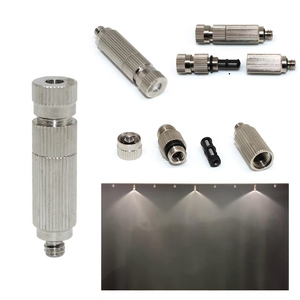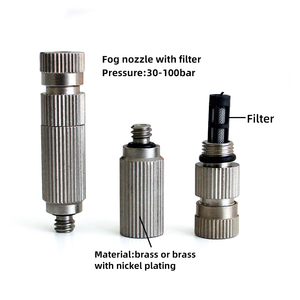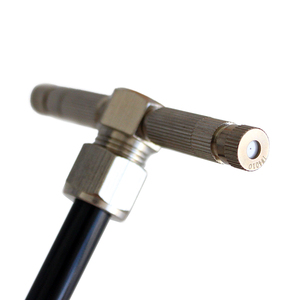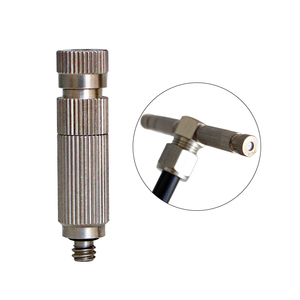
All categories
Featured selections
Trade Assurance
Buyer Central
Help Center
Get the app
Become a supplier

(11391 products available)




















































Plastic mist nozzles are designed to create a fine spray or mist of liquid, typically for applications such as irrigation, cooling, humidification, or spraying. They are made from durable plastic materials and can be classified in different ways.
By Construction:
There are two plastic mist spray nozzle designs. The first is a simple design involving a single component, while the second has multiple components. Single-component nozzles have fewer parts to assemble, which reduces production costs and the risk of faulty assembly. They are also easier to use and maintain. Multiple-component nozzles can have more complex designs that allow for better spray control and atomization. They are, however, more expensive and take longer to assemble.
By Shape:
The plastic mist nozzles come in different shapes to meet different needs. Cone nozzles produce a conical spray pattern suitable for many applications. Flat fan nozzles produce a flat, even spray ideal for coverage. Hollow cone nozzles produce a hollow cone suitable for precise applications. Full cone nozzles produce a complete cone for maximum coverage. Adjustable nozzles allow users to change the spray angle to suit different tasks.
By Material:
Different types of plastics are used to make mist nozzles. Each one has unique properties that make it suitable for particular uses. Polypropylene (PP) is a strong, lightweight plastic that is resistant to many chemicals. It works well for nozzles used in agriculture and industry. Polyvinyl Chloride (PVC) is affordable and easy to mold, making it suitable for irrigation. Polyethylene (PE) can bend without breaking, so it is good for humidifiers and misting systems. Acrylonitrile Butadiene Styrene (ABS) is tough and can withstand heat and cold, making it suitable for outdoor use. Nylon is strong and can handle friction, so it is used in nozzles for automotive and machinery.
Misting nozzles are designed to produce a fine mist or spray of water. The design elements of these nozzles are as follows:
Design elements:
The body of the nozzle is usually made of brass or plastic. Brass can withstand high pressure and is durable. Plastic is lightweight, and cheap, but it can only stand low pressure. The design of the body can be straight or curved. The straight design is simple, while the curved design can spread the mist better. The tip or end of the nozzle is where the mist comes out. There are different designs of tips. Some tips have small holes to create a fine mist. Some tips have a mesh screen to break the water into small droplets. The mesh screen tips are good for making a fine mist. The threaded part of the nozzle allows users to attach the nozzle to a hose or pipe. Some nozzles have quick-connect fittings. These fittings make it fast and easy to connect and disconnect the nozzle. Some nozzles have adjustable settings. They allow users to change the amount of water that comes out. They also allow users to change the width of the spray. Nozzles with adjustable settings are versatile. They can be used for different purposes.
Aesthetic considerations:
Misting nozzles are usually small. Their shapes are simple. They are designed to blend in. They do not draw much attention. Brass nozzles have a shiny metallic look. It makes them look elegant and professional. Plastic nozzles come in many colors. They can match the surroundings. They can also help users quickly identify the nozzle type.
Plastic mist nozzles are used in various industries and applications. They provide controlled and precise spraying and are beneficial in the following areas:
Agriculture
The plastic mist nozzles are used for spraying pesticides and herbicides on crops. The nozzles provide a uniform coverage of the chemicals over the plant. They ensure that the misting of the chemicals is even and reduce the amount of solution that is needed. These nozzles are also used in greenhouses to create a fine mist that helps regulate humidity and temperature and provide the plants with the moisture they need without overwatering.
Horticulture and landscaping
In this industry, the plastic mist nozzles are used for watering plants and creating beautiful water features. They are also used for fogging systems, which control pests and diseases in gardens and landscapes without using chemical treatments. Moreover, these nozzles are used for tender plants that need gentle watering.
Industrial applications
Plastic mist nozzles are used for cooling, dust control, and fog generation. They are used in manufacturing processes to cool down machines and tools. The mist created by the nozzle absorbs heat, thus lowering the temperature. These nozzles suppress airborne particles and reduce the risk of respiratory hazards to workers. In some applications, the nozzles are used to create artificial fog for special effects in theme parks and haunted houses.
Food and beverage industry
In this industry, mist nozzles are used for washing fruits and vegetables. The gentle mist properly cleans the produce without damaging them. These nozzles are used in the packaging of fresh produce to keep the fruits and vegetables fresh. They are also used in the brewing process to cool the ingredients.
Electronics
The plastic mist nozzles are used for cleaning electronic components and devices. The gentle mist can remove dust and other contaminants without damaging delicate parts. This application is important for maintaining the performance of the devices and extending their lifespan.
Medical field
Plastic mist nozzles are used to produce aerosolized medications. These are drugs that are intended to be inhaled. The nozzles create a fine mist that is easy to inhale and reach the lungs. Mist nozzles can also produce a mist that increases humidity. This is used in medical settings to treat patients with respiratory problems. The nozzles are also used in laboratories to create fog for scientific experiments.
Some factors plastic mist nozzle buyers should consider when choosing a nozzle are as follows.
Operation Purpose:
When buying plastic mist nozzles, buyers should consider what they will use them for. If they need to water plants, nozzles that make big droplets or light mist would work better. However, if they want to spray fine mist perfumes or pesticides, nozzles that make very fine, even mists would be better. The intended use should guide the selection of the nozzle.
Misting Nozzle Types:
There are different kinds of misting nozzles. Mechanical nozzles are simple and spray a fine mist without needing power. Pressure misting nozzles work well for large areas or big machines. Ultrasonic mist makers use special vibrations to make very fine mist for small areas. High-pressure misting nozzles use compressed air or water to create a cooling mist for outdoor patios. Buyers should choose the suitable misting nozzle type according to their needs.
Material and Durability:
Plastic mist nozzles are lightweight and cost-effective, suitable for many applications. But if the nozzles will be used in tough environments with hot liquids or chemicals, metal nozzles may last longer. The material should match the working conditions to ensure the nozzle lasts a long time.
Pressure and Flow Rate:
Each misting nozzle works well at certain pressures. The nozzle also has a maximum flow rate. Buyers should ensure the water pressure in their system matches the nozzle's working pressure range. The nozzle should also be able to handle the water flow rate for the intended application. If the pressure is too high or low for the nozzle, it won't work well.
Spray Pattern and Droplet Size:
Different nozzles spray in different patterns and make different sized droplets. Some nozzles spray straight ahead. Others spray wide or fine mists. Depending on the use, buyers may want a certain spray pattern and droplet size. For example, a wide spray may work for watering, while a fine mist may be better for cooling.
Adjustability:
Some nozzles allow users to change the flow rate or spray pattern. This adjustability lets users customize the mist for different tasks. It is useful if the nozzle will be used for several purposes. Fixed nozzles work well if the same setting is always needed.
Connection Size and Compatibility:
The nozzle should fit the existing pipes or hoses. If not, adapters may be needed. Check that the nozzle size matches the connections in the spraying system. Make sure the nozzle is compatible with the misting system.
Ease of Maintenance:
Plastic mist nozzles are usually easy to clean and maintain. This prevents clogging and extends their life. Choose nozzles that do not require frequent maintenance so that they can work reliably over a long time.
Q1: What are the benefits of using a plastic mist nozzle?
A1: Plastic mist nozzles are lightweight, cost-effective, and resistant to chemicals and corrosion. They create a fine, uniform spray ideal for cooling, humidifying, and irrigation applications.
Q2: How do mist nozzles help in cooling?
A2: When water droplets evaporate from the nozzle's mist, they absorb heat, lowering the surrounding temperature. This is the cooling effect of the nozzles.
Q3: Can mist nozzles be used for irrigation?
A3: Mist nozzles are suitable for delicate plants that require a high humidity level or regular watering. They provide a gentle mist that wets without disturbing the soil.
Q4: How can one maintain a plastic mist nozzle?
A4: Regular cleaning is part of good maintenance. It removes mineral buildup and checks for wear and tear. The nozzle may be replaced if it is damaged to maintain performance.
Q5: What factors should one consider when choosing a mist nozzle?
A5: The application, flow rate, droplet size, and compatibility with existing systems are among the factors to consider. These factors will help one choose a suitable nozzle for the needs.